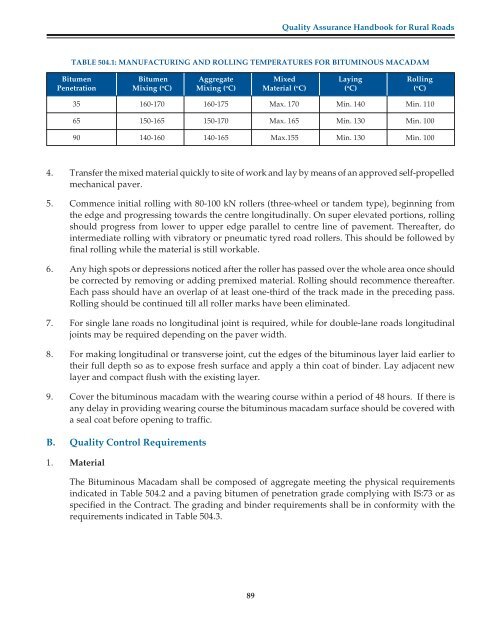Quality Assurance Handbook for Rural Roads Volume-I - pmgsy
Quality Assurance Handbook for Rural Roads Volume-I - pmgsy
Quality Assurance Handbook for Rural Roads Volume-I - pmgsy
Create successful ePaper yourself
Turn your PDF publications into a flip-book with our unique Google optimized e-Paper software.
89<br />
<strong>Quality</strong> <strong>Assurance</strong> <strong>Handbook</strong> <strong>for</strong> <strong>Rural</strong> <strong>Roads</strong><br />
TABLE 504.1: MANUFACTURING AND ROLLING TEMPERATURES FOR BITUMINOUS MACADAM<br />
Bitumen Bitumen Aggregate Mixed Laying Rolling<br />
Penetration Mixing ( o C) Mixing ( o C) Material ( o C) ( o C) ( o C)<br />
35 160-170 160-175 Max. 170 Min. 140 Min. 110<br />
65 150-165 150-170 Max. 165 Min. 130 Min. 100<br />
90 140-160 140-165 Max.155 Min. 130 Min. 100<br />
4. Transfer the mixed material quickly to site of work and lay by means of an approved self-propelled<br />
mechanical paver.<br />
5. Commence initial rolling with 80-100 kN rollers (three-wheel or tandem type), beginning from<br />
the edge and progressing towards the centre longitudinally. On super elevated portions, rolling<br />
should progress from lower to upper edge parallel to centre line of pavement. Thereafter, do<br />
intermediate rolling with vibratory or pneumatic tyred road rollers. This should be followed by<br />
final rolling while the material is still workable.<br />
6. Any high spots or depressions noticed after the roller has passed over the whole area once should<br />
be corrected by removing or adding premixed material. Rolling should recommence thereafter.<br />
Each pass should have an overlap of at least one-third of the track made in the preceding pass.<br />
Rolling should be continued till all rolIer marks have been eliminated.<br />
7. For single lane roads no longitudinal joint is required, while <strong>for</strong> double-lane roads longitudinal<br />
joints may be required depending on the paver width.<br />
8. For making longitudinal or transverse joint, cut the edges of the bituminous layer laid earlier to<br />
their full depth so as to expose fresh surface and apply a thin coat of binder. Lay adjacent new<br />
layer and compact flush with the existing layer.<br />
9. Cover the bituminous macadam with the wearing course within a period of 48 hours. If there is<br />
any delay in providing wearing course the bituminous macadam surface should be covered with<br />
a seal coat be<strong>for</strong>e opening to traffic.<br />
B. <strong>Quality</strong> Control Requirements<br />
1. Material<br />
The Bituminous Macadam shall be composed of aggregate meeting the physical requirements<br />
indicated in Table 504.2 and a paving bitumen of penetration grade complying with IS:73 or as<br />
specified in the Contract. The grading and binder requirements shall be in con<strong>for</strong>mity with the<br />
requirements indicated in Table 504.3.
















